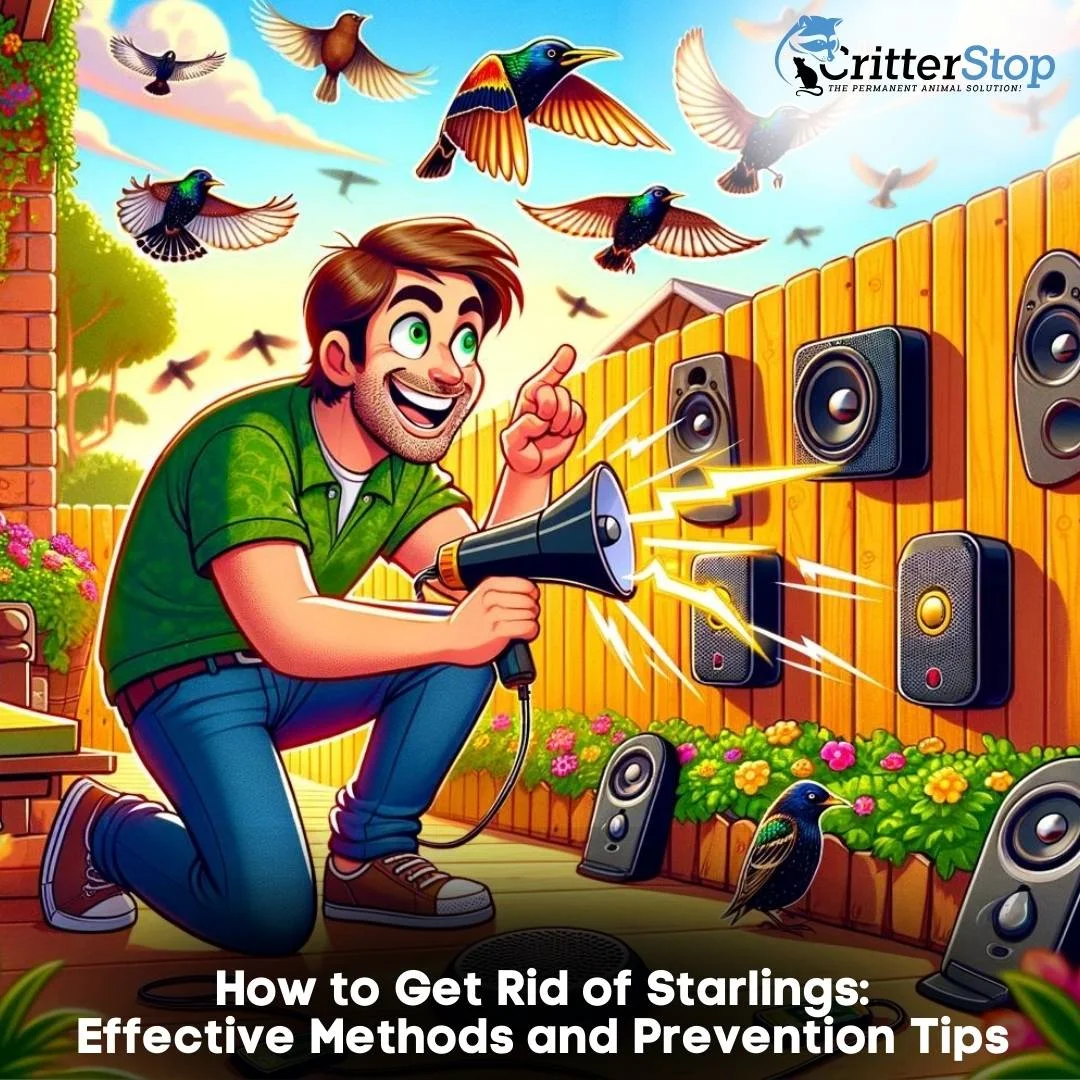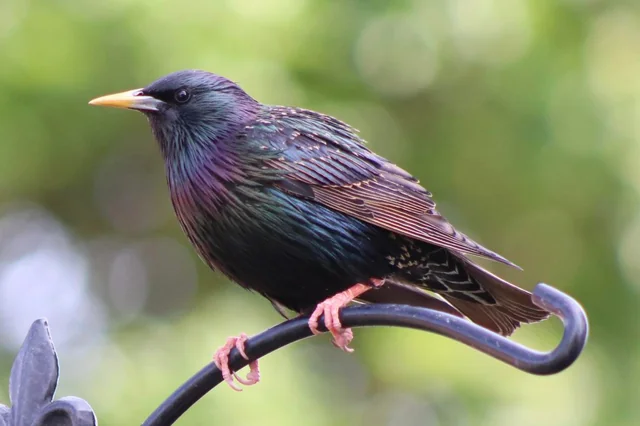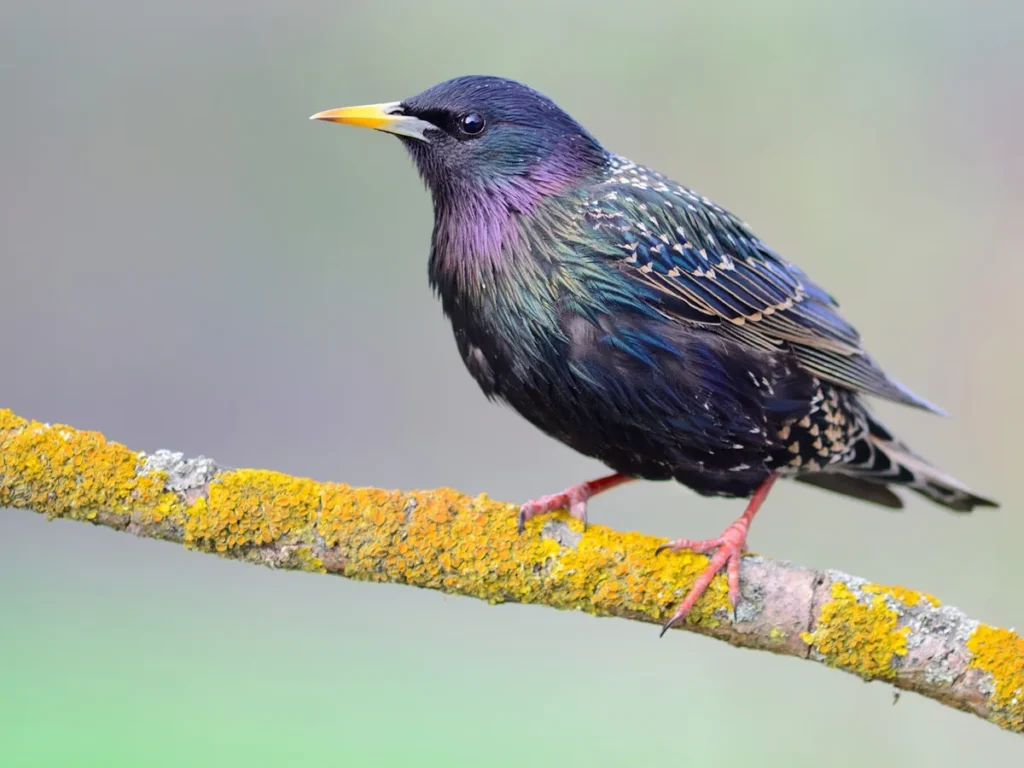
Starlings are a common bird species found in many parts of the world. While they may be pleasant to look at and listen to, they can also become a nuisance for homeowners and farmers. Starlings are known for their aggressive behavior and their tendency to flock in large numbers, causing damage to crops and structures. In this article, we will explore some effective ways to get rid of starlings.
One of the most effective ways to get rid of starlings is to make their roosting and nesting areas less attractive. Starlings are attracted to areas that provide them with shelter, food, and water. By removing these resources, you can discourage them from roosting and nesting on your property. This can be done by removing bird feeders, sealing off openings in buildings, and removing standing water.
Another effective method for getting rid of starlings is to use bird repellents. There are several types of bird repellents available on the market, including visual, auditory, and chemical repellents. Visual repellents include reflective surfaces and scare devices, while auditory repellents include high-pitched sounds and distress calls. Chemical repellents include sprays and gels that emit an unpleasant odor or taste. These repellents can be used to discourage starlings from roosting and nesting in specific areas.

Starlings are a common bird species found in many parts of the world. While they may seem harmless, they can actually cause a number of problems for humans. Here are some reasons why starlings are a problem:
Starlings can cause damage to property when they build their nests in or around buildings. They may also peck at wood, causing damage to siding, eaves, and other parts of a structure. Additionally, their droppings can be unsightly and may cause damage to paint, metal, and other materials.
Starlings can also cause damage to crops and gardens. They may eat fruits and vegetables, causing significant damage to crops. They may also damage gardens by pulling up plants and digging up soil.
Starlings are known for their loud and persistent calls, which can be a nuisance to humans. They may also congregate in large flocks, creating a lot of noise and disturbance.
Overall, while starlings may be an interesting bird species to observe, they can also cause a number of problems for humans. It is important to take steps to control their populations and prevent damage to property, crops, and gardens.
Starlings can be a nuisance to homeowners and farmers alike. Fortunately, there are several effective deterrents that can help keep these birds away from your property.
Netting is a popular option for keeping starlings away from crops and gardens. The netting should be placed over the plants, creating a barrier that the birds cannot penetrate. This can be an effective way to keep starlings from eating your fruits and vegetables.

Spikes can be placed on ledges and other areas where starlings like to perch. The spikes make it uncomfortable for the birds to land on these surfaces, discouraging them from returning. This can be an effective way to keep starlings away from your home or business.
Starlings are sensitive to loud noises, so using noise as a deterrent can be effective. There are several devices available that emit loud noises at regular intervals. This can be an effective way to keep starlings away from your property.
It's crucial to highlight that although these preventive measures can prove efficacious, they might not be suitable for all scenarios. It's equally vital to employ these approaches with compassion, ensuring no harm comes to the birds population. By using these methods responsibly, you can effectively keep starlings away from your property.
When it comes to getting rid of starlings, physical deterrents are an effective and humane option. Physical deterrents work by making the area less attractive to starlings, preventing them from nesting or feeding in the area. Here are some of the most effective physical deterrents:

Sound deterrents are an effective way to keep starlings away from an area. They work by emitting loud, high-pitched noises that are unpleasant to birds. This can include sonic devices that emit bird distress calls or predator sounds. Another option is to play music or other loud noises that will deter the birds.
Visual deterrents can be effective in deterring starlings from an area. One option is to use scarecrows or other decoys that resemble predators. Another option is to use reflective surfaces or shiny objects that will scare the birds away. This can include hanging CDs or other reflective objects around the area.
Chemical deterrents can be effective in preventing starlings from nesting or feeding in an area. One option is to use bird repellent sprays that contain natural ingredients like peppermint oil or garlic. Another option is to use chemical bird repellents that contain chemicals that are unpleasant to birds.
It is important to keep in mind that physical deterrents are most effective when used in combination with other methods, such as removing food sources or blocking off access to nesting areas. For best results, it may be necessary to consult with a professional wildlife control company that specializes in bird removal.
One effective way to get rid of starlings without harming them is to modify their habitat. This involves making the area less attractive to the birds by removing sources of food and shelter.
Start by removing any bird feeders or other sources of food that may be attracting the starlings. If you must have a feeder, switch to a type that only allows smaller birds to access the seed, or use a tray that can be removed at night.
Next, remove any potential nesting sites from the area. This may involve filling in holes in buildings or trees, or installing netting or spikes to prevent access to roofs and other areas where the birds may nest.
Finally, consider planting trees or shrubs that are less attractive to starlings, such as those with thorns or prickly leaves. This will make the area less hospitable to the birds and encourage them to move on to a more suitable location.
Another non-lethal way to get rid of starlings is to use exclusion techniques. This involves physically preventing the birds from accessing the area.
One effective method is to install bird netting over areas where the starlings may be roosting or nesting. This will prevent the birds from accessing the area and force them to find a new location.
Another option is to install spikes or other deterrents on ledges or other areas where the birds may be roosting. These devices make it difficult for the birds to perch and discourage them from returning to the area.
If these techniques prove ineffective, it might be imperative to enlist assistance from a certified wildlife management service. They can provide more advanced exclusion techniques and other methods to safely and effectively remove the starlings from the area.
By implementing these non-lethal methods, it is possible to quickly and effectively get rid of starlings without harming the birds or resorting to extreme measures.
Habitat modification is an effective way to get rid of starlings. It involves making changes to the environment to make it less attractive to starlings. This section will cover two important aspects of habitat modification: food source management and nesting site reduction.
Starlings are attracted to areas with abundant food sources. Therefore, managing the food source is an effective way to reduce the number of starlings in the area. This can be done by:
Starlings build their nests in cavities, such as those found in trees, buildings, and birdhouses. Therefore, reducing the number of nesting sites can help get rid of starlings. This can be done by:
By implementing these habitat modifications, you can effectively reduce the number of starlings in your yard or area.
When non-lethal control methods fail to get rid of starlings, lethal control methods may become necessary. Lethal control methods involve the use of lethal devices to remove starlings from an area. These approaches ought to be considered a final option and employed with care, as they carry risks of harm to unintended species and potential danger to humans.
Shooting is an effective method of controlling starling populations, but it requires a skilled marksman and may not be appropriate in all areas. Shooting should be done only by professionals who have been trained in the safe and humane use of firearms. Shooting should be done in a way that ensures that non-target species are not harmed, and that the public is not put at risk.
Trapping is another effective method of controlling starling populations. Traps should be placed in areas where starlings are known to roost or feed. Traps ought to be routinely inspected to guarantee prompt removal of captured birds. Trapped birds should be euthanized in a humane manner.
Poisoning is a controversial method of controlling starling populations. Poisoning should only be done by professionals who have been trained in the safe and humane use of poisons. Poisoning should be done in a way that ensures that non-target species are not harmed, and that the public is not put at risk. Resorting to poisoning should be considered only as a last-ditch effort after exhausting other methods.
In conclusion, lethal control methods should be used only as a last resort when non-lethal control methods have failed. These methods should be used with caution and only by professionals who have been trained in the safe and humane use of lethal devices.
When addressing the removal of starlings, it's vital to contemplate the ecological repercussions of your actions. Despite their nuisance factor, starlings play a significant role in the ecosystem. Hence, it's crucial to employ safe methods that preserve the well-being of other local fauna and flora.
One effective method is to use exclusion techniques, such as bird netting or bird spikes, to prevent starlings from accessing certain areas. These methods are safe and humane, as they do not harm the birds and simply prevent them from roosting or nesting in unwanted areas.
Another method is to use non-lethal deterrents, such as loud noises or flashing lights, to scare the birds away. These methods are also safe and do not harm the birds or other animals in the area.
Before taking any action to get rid of starlings, it is important to consider the legal implications. In some areas, starlings are protected under wildlife laws and it may be illegal to harm or kill them without a permit.
Therefore, it is important to check with local wildlife authorities or conservation groups to ensure that any methods used to get rid of starlings are legal and in compliance with regulations.
Moreover, it's essential to contemplate the potential repercussions on other wildlife species in the area For example, using pesticides to control starlings may also harm beneficial insects or other animals.
Overall, the best practices for getting rid of starlings involve using safe and humane methods that do not harm the environment or other animals in the area. By considering both environmental and legal considerations, individuals can effectively control starling populations while minimizing any negative impacts.

In summary, getting rid of starlings involves creating an environment that is not conducive to their nesting and feeding habits. This can be achieved by removing food sources, deterring them with physical barriers or noise, and limiting their access to nesting areas.
The first step is to keep bird feeders clean and free of seed debris, which can attract starlings. Additionally, it is important to seal any holes or gaps in buildings where starlings may try to nest. Netting and spikes can also be effective deterrents to keep starlings away from areas where they are unwanted.
If starlings have already established a nest in a yard or building, it is important to remove it quickly and safely. At Critter Stop, we can help you with your Starling problem! Contact us at (214) 234-2616 and let the professionals handle this situation. We have provided our bird removal services all over the Texas area, with our unique approach, we can get rid of starlings effectively and humanely.
Overall, getting rid of starlings requires a combination of preventative measures and removal techniques. While it may take some effort and persistence, it is possible to effectively control starling populations and prevent damage to property and crops. By following these steps and remaining vigilant, property owners can successfully deter starlings and protect their space from these pesky birds.
There are several effective methods for repelling starlings, including physical barriers, visual deterrents, and sonic devices. Structures like netting or wire mesh can be erected as physical barriers to impede starlings from accessing specific areas. Visual deterrents like scarecrows, reflective tape, or decoys mimicking predators can also prove effective in dissuading starlings. Sonic devices emit high-pitched sounds that are unpleasant to starlings and can be used to keep them away from your property.
Ultrasonic devices emit high-frequency sounds that are designed to be unpleasant to birds, including starlings. While some ultrasonic devices have been shown to be effective in repelling birds, others have not. It is important to choose a high-quality ultrasonic device that is specifically designed for repelling starlings.
There are several sprays on the market that are designed to prevent starlings from gathering in certain areas. These sprays typically contain natural ingredients that are unpleasant to birds, such as peppermint oil or capsaicin. However, it is important to note that these sprays may also be unpleasant to other birds and wildlife, so they should be used with caution.
Starlings are notorious for raiding bird feeders, but there are several modifications that can be made to prevent them from accessing the food. One option is to use a feeder with a cage or mesh surrounding it, which allows smaller birds to access the food while keeping starlings out. Another option is to use a feeder with weight-sensitive perches, which will close off access to the food when a heavier bird like a starling lands on it.
There are no bird-safe poisons that specifically target starlings. In fact, the use of poisons to control bird populations is generally discouraged, as it can harm other wildlife and disrupt the ecosystem.
There are several natural deterrents that can be used to keep starlings at bay. These include planting certain types of trees or shrubs that are unappealing to starlings, such as holly or juniper. Another option is to create a habitat that is attractive to birds that prey on starlings, such as hawks or owls. Furthermore, maintaining cleanliness on your property and ensuring there's no food waste can deter starlings from congregating in the vicinity.
Visit our Critter Library and learn more about our furry friends